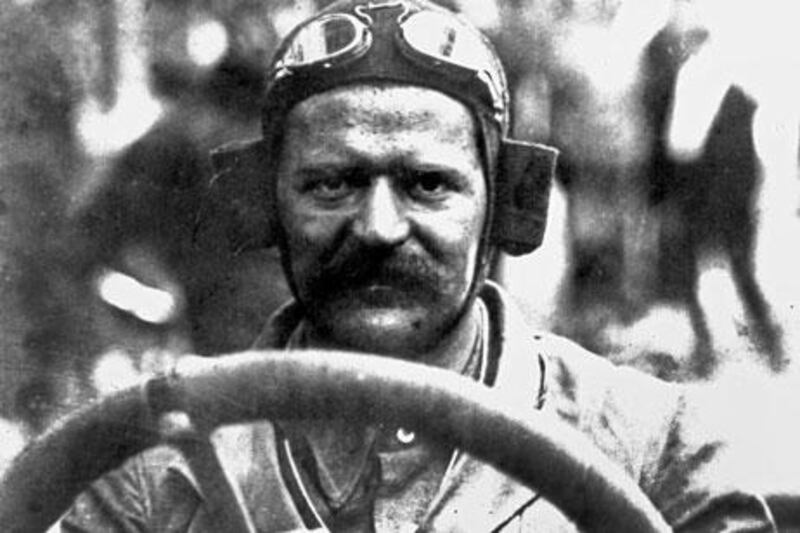Chevrolet is an American icon, as synonymous with the US as the Statue of Liberty, the right to bear arms and the McDonald's hamburger. Over the last century millions of Americans have driven their Chevy to the levy, diner or Walmart with an elbow out of the window and a beaming smile of home-grown pride in the miracle of American enterprise. From Manila to Montenegro and back to Maryland, the Chevy is a cultural marker that America has conquered the industrial age, as evocative an image as the Stars and Stripes fluttering on the surface of the moon. On Thursday the brand celebrated 100 years since its foundation.
The story of Chevrolet is a rags to riches to rags tale that is the quintessential embodiment of the American dream. Louis Chevrolet, the co-founder of the car brand, came to rest amid the dirt and industrial din of Detroit, but his journey began thousands of miles away in the peaceful, pastoral alpine valleys of Switzerland. His life didn't just span cultures and continents but ages. His is more than the story of a car; it is the narrative of an era - an era in which opportunity was always over the next horizon.
The son of a humble watchmaker, Chevrolet left his homeland at the age of eight to make the short journey over the border to France, where his father looked for work after an economic slump. With a family to feed and his father struggling to make ends meet, Louis left school at 11 to work in a local bicycle shop. He soon showed promise, inheriting his father's technical curiosity and eye for detail. But he was not destined to remain a mere mechanic for long. By 16 he had designed his own bicycle, the Frontenac, and rode it to victory in local races that were a popular spectator sport of the time. His wins brought bread to the family table but, more importantly, sowed the seeds of a passion for speed that was to define the rest of his life.
It is an urban myth, and therefore by definition a version of events that appeals more to the dramatic heart than the deductive mind, that, while visiting Europe, the multimillionaire railway magnate Willie Vanderbilt chanced upon young Chevrolet's shop to have his three-wheeled bike repaired. So impressed was he, so the story goes, by Chevrolet's technical ability that he encouraged the boy to fulfil his talents across the Atlantic. The boy took heed and, after transferring to the famous Darracq cycles of Paris and working on an internal combustion engine for the first time, that is just what he did. His first destination was Montreal, Canada, where he worked as a mechanic and chauffeur before moving to New York in 1901 to work for the French manufacturer De Dion-Bouton, at that time the largest car company in the world. But Chevrolet was still young and ambition coursed through his veins. By his late twenties, he had established himself as a dashing darling of the race track, if not a Sebastian Vettel then certainly a Lewis Hamilton of his age. And as if fate were playing its hand of unerring coincidence, his reputation was made by breaking the fastest mile in the Vanderbilt Cup, named after the patriarchal patron of motorsport who had once had his chain fixed by a young Swiss mechanic.
Despite a rather effete moustache, Chevrolet was a muscular man, which served him in good stead in those pioneering years of motorsport, where cars were leviathans that had to be wrestled around the track. Suspension was still based on back-breaking cart springs and terms such as servo-assistance and power steering were in the realms of science fiction. These cars not only had to be driven, they had to be conquered. His fame and fortune were being built by each race he drove for all the leading marques of the time, moving from Fiat to Darracq and finally, in 1909, to Buick. It was there that he met fellow driver William C Durant, a founder of General Motors. These two men, though far from friends, were to make motoring history. Durant was the pragmatist to Chevrolet's perfectionist but, in such disparities, pioneering partnerships are forged. Durant was not only a talented racing driver but a very shrewd businessman.
He recognised Chevrolet's engineering acumen, but he also saw the value of the Chevrolet name - one that already resonated in the public imagination from his racing successes. It would be a perfect name to back a new car.
In November 1911, the Chevrolet brand was born. The first model was an imposing and impressive six-cylinder racer. But with a price tag of more than US$2,000 (Dh7,350), it was only within reach of the rich.
Chevrolet was unwilling to accept Durant's prescient advice that, to grow, the company had to target the mass market. It was Ford's model that would bring in the bucks and make their brand an institution. Durant wanted to build a dynasty whereas Chevrolet wanted to find notoriety and, like many a Hollywood marriage, the partnership quickly unravelled at the seams.
Chevrolet had no wish to build prams, so he threw his toys out of it and sold his stake in the company a mere two years after the brand was formed. In this simple rash, snobbish action, he gave up an opportunity to be one of the richest men in America.
While the marque that bore his name was subsumed into General Motors and grew into one the most respected and widely purchased cars in the world, Chevrolet sought solace in the smaller, elite world of motorsport; a world in which he thought his genius could bear riper fruits. He reformed the Frontenac brand from his youth and built acclaimed engines for Monroe Ford. His rash decision must have seemed vindicated when he drove his own car to the land speed record in 1917 before his brother, Gaston, claimed victory for Frontenac at the 1920 Indianapolis 500.
But this happiness proved brief and tragedy struck in 1922 when Gaston was killed during a race. Louis was inconsolable and swore never to race again. His fortunes faded fast. After Frontenac failed, he tried his hand with boats and then aircraft before losing everything in the Wall Street Crash of 1929.
By then, Chevrolets were on the cusp of outselling Ford in the early 1930s, and the gold bow tie - a stylised Swiss cross that honours Chevrolet's homeland - was one of the most recognisable emblems on Earth. Durant had been right and, by evolving mass production with innovation, the company was set to dominate car sales for the next half a century.
In a desperately sad twist of fate, Chevrolet, down on his luck and destitute, returned to the marque that bore his name. But it was not a triumphant return: he toiled as a lowly mechanic on the assembly line. Injured from crashes and invisible to everyone, he plied his modest trade, a simple mechanic once more until forced to retire from ill health in 1934. He died seven years later, in poverty, aged 62.
A memorial was erected in his honour in Indianapolis in 1975, but Chevrolet didn't need a bronze bust to be immortalised; by then, one in every 20 cars in the world bore his name.
Follow more stories of the characters that formed the auto industry in Tim Brooks' new series, Making Their Marque, appearing twice a month in Motoring






